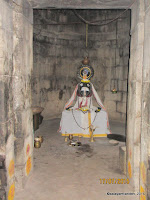

Kailaya Eswaramudaiya Mahadevar Temple (கைலாய ஈஸ்வரமுடைய மஹாதேவர் கோவில் கேசவரம்) is located in Kesavaram (கேசவரம்) village, Arakkonam taluk, Vellore district, Tamil Nadu, India PIN 631151. and Kesavaram (கேசவரம்) village forms part of Pudukesavaram Panchayat. Kesavaram is the transitioned form of Kailaya Eswaram (கைலாய ஈஸ்வரம்).
 |
| Kesavaram Dam. The Hindu |
The 136 km long Kosasthalaiyar River (கொசஸ்தலையார் ஆறு), also known as Kortalaiyar River (கொற்றலையார் ஆறு), originates near Kaveripakkam in Vellore District. At Kesavaram dam (கேசவரம் அணைக்கட்டு), the river splits into two i.e., Kosasthalaiyar (கொசஸ்தலையார் ஆறு) and Cooum rivers (கூவம் ஆறு). Cooum river receives the surplus water from Cooum tank (கூவம் ஏரி), in Cooum village. Kesavaram dam is located 72 km from Chennai. An island was formed by the confluence of two rivers - Kosasthalayar and Kallaru by encircling and forming the village Kesavaram. Kosasthalayar, believed as Moksha Nadhi, flows from south to north (Uttaravauhini உத்தரவாஹினி) and continue to flow towards Poondi reservoir From Poondi reservoir, Kosasthalaiyar flows through Thiruvallur district, passes through the Chennai metropolitan area, and enters into Bay of Bengal at Ennore creek. At Kesavaram the river bed is dry and surrounded by palm trees. No proper road to reach the temple and you have to walk on the dam bund and even traverse through paddy fields to reach the temple.
Kailaya Eswaramudaiya Mahadevar Temple, a structural stone temple built by Kulottunga Chola I (முதலாம் குலோத்துங்க சோழன்) (1070 – 1122 A.D.), is located about one km away from the Kesavaram dam bund. The east facing temple is in a dilapidated condition and some volunteers have conserved the temple from further damage.
The temple has the sanctum, ardha-mandapam and mukha-mandapam. The gajaprishta vimana is entirely built with granite boulders. It has an ekatala vimana and it has an apsidal (Gajapriishta) plan from adhishtana to shikara, recalling the earlier Buddhist chaitya. The apsidal vimana sits on an apsidal adishtana (plinth). The simple pada-bandha adhishtana (பாதபந்த அதிஷ்டானா) with upa-peeta (உப பீடம்), jagadi (ஜகதி), tripatta kumuda (முப்பட்டைக் குமுதம்), khanta (கண்டம்) with pada and flanked by kampa (கம்பு) and pattika (பட்டிகை) mouldings.
The pada (walls) of the vimana and ardha-mandapam have simple punctuated by brahmakanta pilasters. The walls of the adi-tala of the vimana are divided into three segments called the pathis or bhadras. Devakoshtas flanked by brahmakanta pilasters are sculpted in the central sala bhadras or sala pathis. The upper end of the pilasters are ornamented with kalasa, tadi, kudam, pali, palakha and virakanda. Dakshinamurti in the niche or devakoshtha on the south side of the vimana; Lingodbhava in the niche on the west side; and the north side of the niche houses the priest god Brahma. Sthanaka Vinayaka in the niche or devakoshta located on the south side of the ardha-mandapam; and the north side of the niche houses the goddess Durga. The lintel portions of the koshtas are bereft of any toranas Pilasters support uttara and above uttara is the prastara components including vajana, valabhi and kapota ornamented with kudu at regular intervals. Above the kapota is the bhumidesa denoting the end of the tala. Bhumidesa has the frieze of yali heads.
The super structure of the vimana is built with granite boulders. The apsidal griva (neck) rises above bhumidesa. The griva koshtas or niches are sculpted on three sides. Dakshinamurti in the south griva koshta; Narasimha in the west koshta and Brahma in the north koshta. On top of this griva is an apsidal shikara. Above griva koshtas, maha-nasikas (horseshoe shaped arches) are sculpted on the surfaces of shikara on all cardinal directions. The kudus of maha-nasikas are decorated with Nataraja in the south, Yoga Narasimha in the west and Brahma in the north.
The super structure of the vimana is built with granite boulders. The apsidal griva (neck) rises above bhumidesa. The griva koshtas or niches are sculpted on three sides. Dakshinamurti in the south griva koshta; Narasimha in the west koshta and Brahma in the north koshta. On top of this griva is an apsidal shikara. Above griva koshtas, maha-nasikas (horseshoe shaped arches) are sculpted on the surfaces of shikara on all cardinal directions. The kudus of maha-nasikas are decorated with Nataraja in the south, Yoga Narasimha in the west and Brahma in the north.

The east facing sanctum houses "Kailaya Eswaramudaiya Mahadevar" (கைலாய ஈஸ்வரமுடைய மகாதேவர்) in the form of Shivalingam.
The inscription Kulottunga Chola I records the gift of Uriyur village as land endowment to Kailaya Eswaramudaiya Mahadevar. The Ezhulagamudaiyaal (ஏழுலகமுடையாள்), the queen of Kulothunga Chola I made grants for the construction of Kailaya Eswaramudaiya Mahadevar temple.
Temple Timing
Kailaya Eswaramudaiya Mahadevar is open during day time. Plan your trip during morning or noon hours and avoid late evenings since it would be difficult to traverse through paddy fields and dam bund.
Temple Timing
Kailaya Eswaramudaiya Mahadevar is open during day time. Plan your trip during morning or noon hours and avoid late evenings since it would be difficult to traverse through paddy fields and dam bund.
How to get here?
Palayakesavaram, a small Village, is located 60 km from Chennai, 17 km from Arakkonam Kesavaram Dam is about 6 km from Thakkolam. The village is situated in the border of the Vellore and Thiruvallur districts
Reference
- Kailaaya Eswaram! Aalayam Kanden. August 21, 2015.
- Kailaya Eswaramudaiya Mahadev Temple - Kesavaram. Indian Columbus. April 11, 2016.
No comments:
Post a Comment